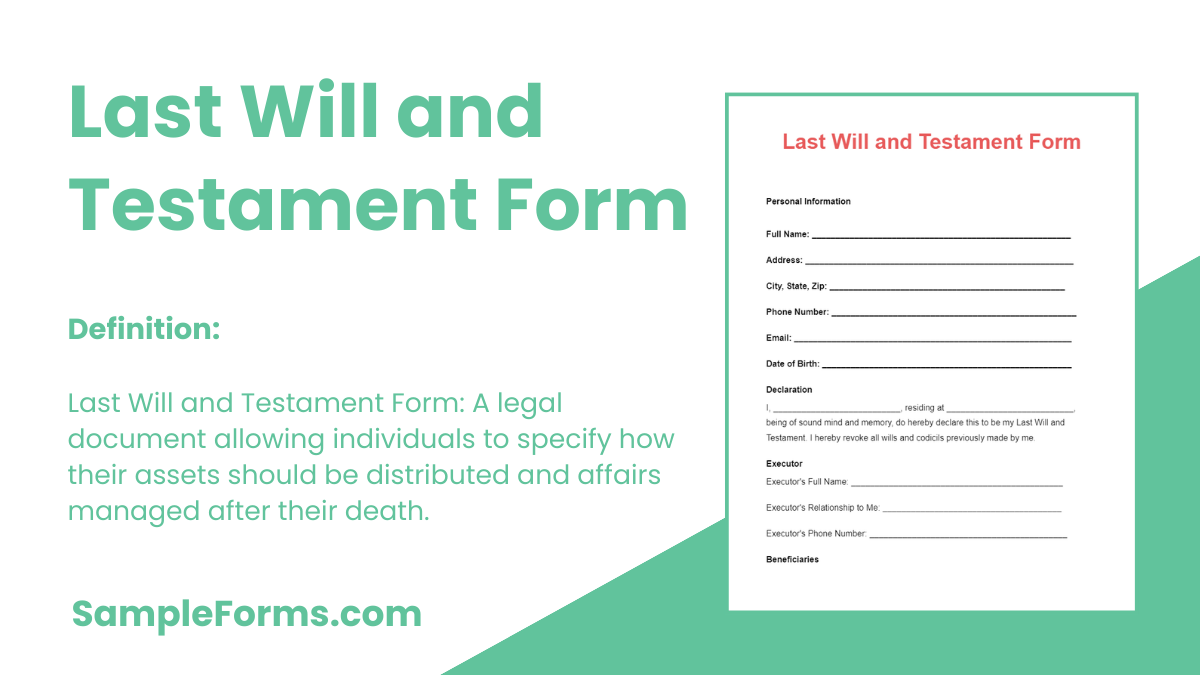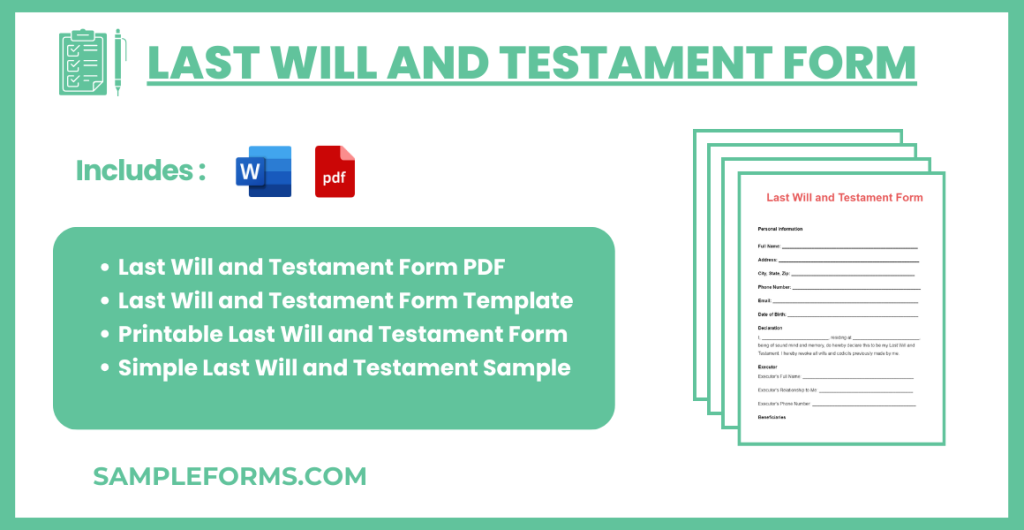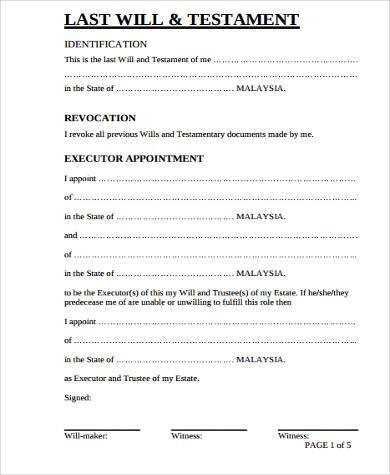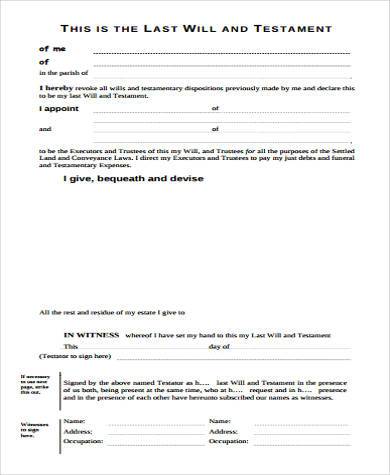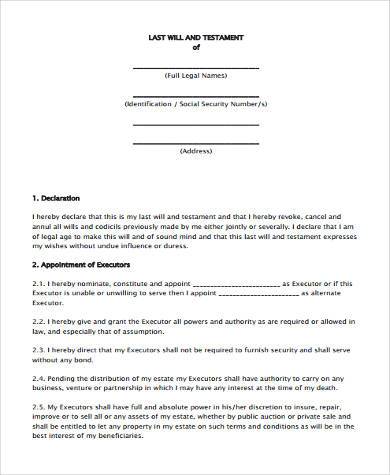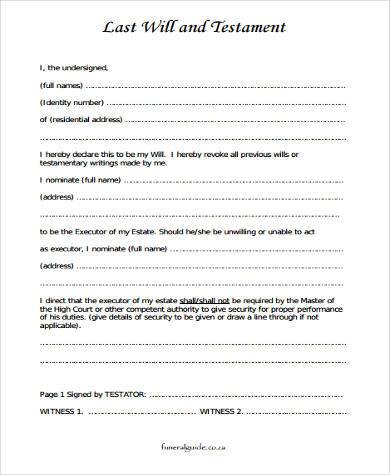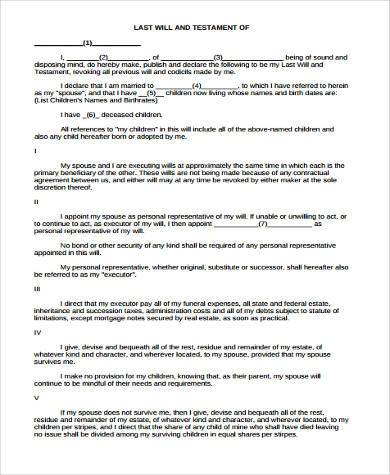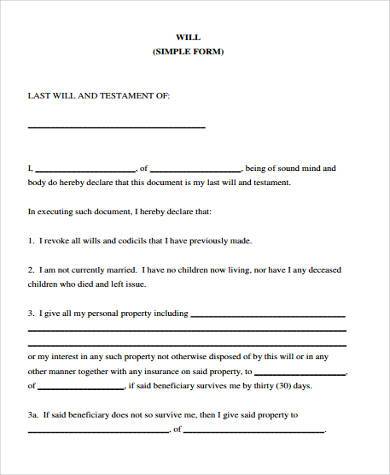Discover the essential steps to crafting your Last Will and Testament with our detailed guide. Including practical examples and thorough explanations, we cover everything from basic definitions to the nuances of a Will Form. Understand how to articulate your final wishes clearly using a Living Will Form document. Start safeguarding your legacy today with our expert insights, designed for clarity, simplicity, and peace of mind.
Download Last Will and Testament Form Bundle
What is a Last Will and Testament Form?
A Last Will and Testament Form is a crucial legal document that allows individuals to specify how they wish their property and affairs to be handled after their passing. It outlines the distribution of assets, care of minors, and personal instructions. Including a Living Will Form within this document further specifies preferences for medical treatment and care in situations where one cannot communicate their wishes directly. Simple, clear, and essential for future planning, a Last Will ensures your legacy is honored as you intend.
Last Will and Testament Format
I, [Full Name], residing at [Address], being of sound mind and memory, do hereby declare this document to be my Last Will and Testament.
Article 1: Executor
- I appoint [Executor’s Full Name] as the Executor of my Will. If [Executor’s Full Name] is unable or unwilling to serve, then I appoint [Alternate Executor’s Full Name] as the alternate Executor.
Article 2: Beneficiaries
- I hereby bequeath the following:
- To [Beneficiary Name], I leave [Description of Bequest].
- To [Beneficiary Name], I leave [Description of Bequest].
Article 3: Guardian for Minor Children (if applicable)
- I appoint [Guardian’s Name] as the guardian of my minor children. If [Guardian’s Name] is unable or unwilling to serve, then I appoint [Alternate Guardian’s Name] as the alternate guardian.
Article 4: Signatures
- This Will was signed on [Date], at [Location], in the presence of the undersigned witnesses, who witnessed and attest to the Testator’s signing of this Will.
Witnesses:
- Name: ___________________________________ Signature: _________________________
- Name: ___________________________________ Signature: _________________________
Last Will and Testament Form PDF
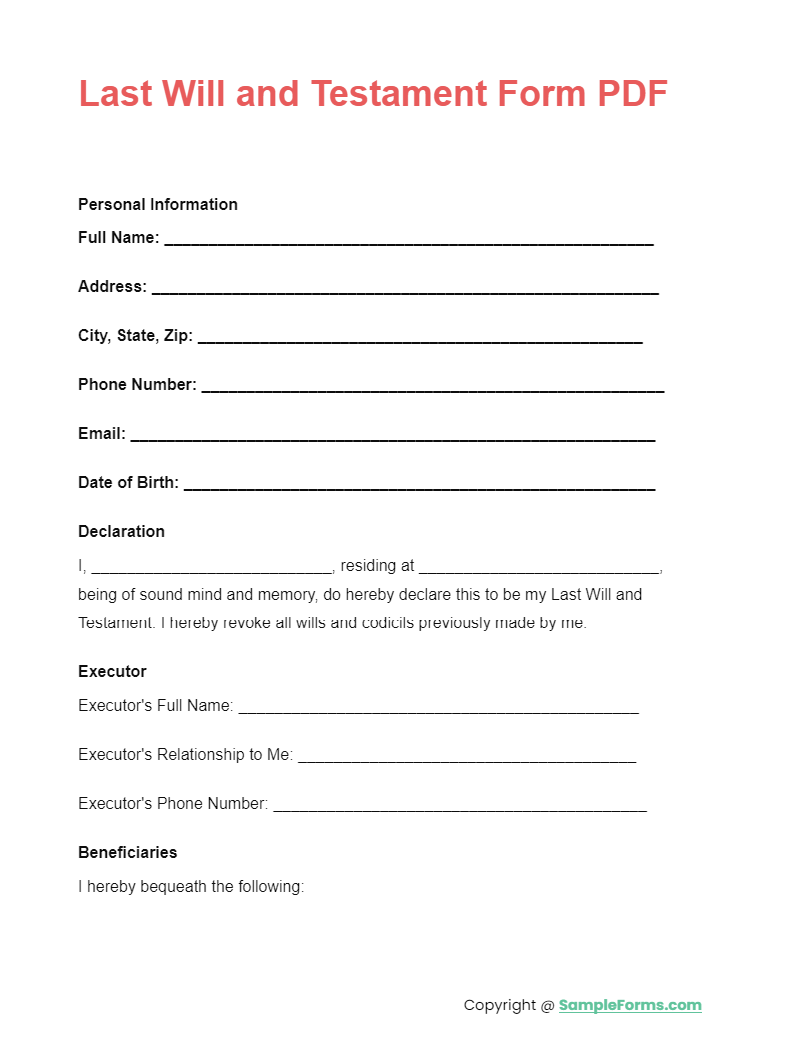
Download a Last Will and Testament Form PDF to securely outline your assets’ distribution. It simplifies creating a will, ensuring it aligns with legal standards, including a Will and Trust Form for comprehensive estate planning. You may also see Property Acknowledgment Form
Last Will and Testament Form Template

Utilize our Last Will and Testament Form Template to start drafting your will today. This template guides you through each step, incorporating crucial elements like a Will Questionnaire Form, making the process clear and legally sound. You may also see Property Release Form
Printable Last Will and Testament Form
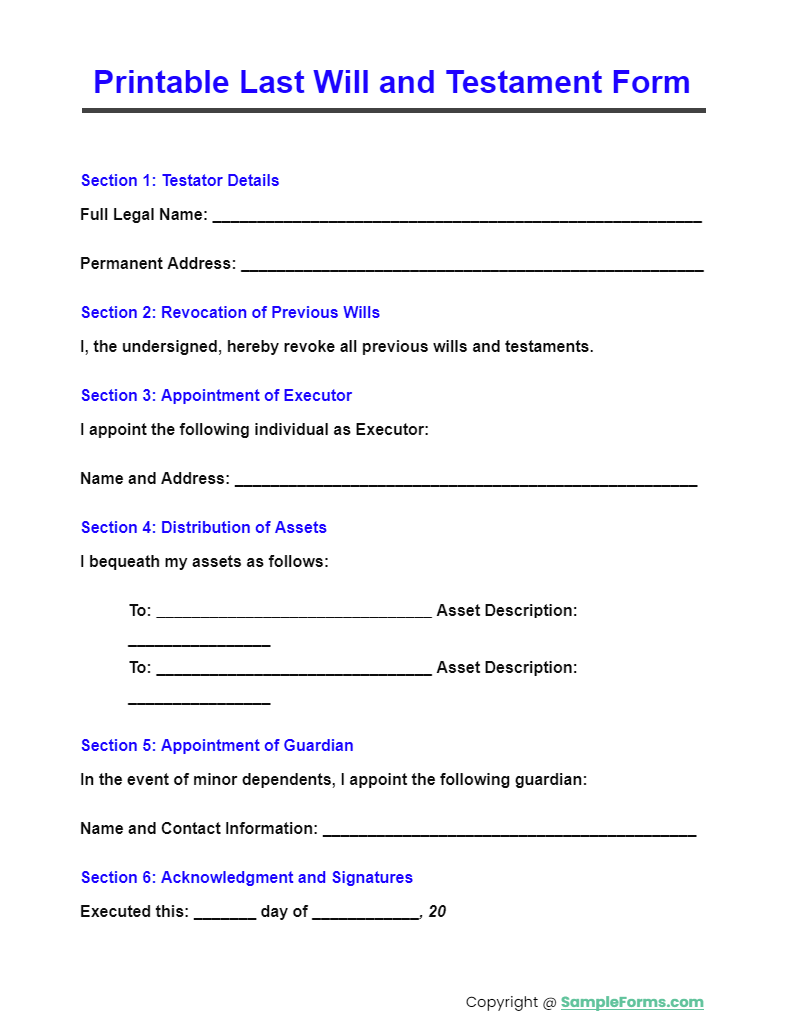
Our Printable Last Will and Testament Form offers an easy-to-use format for detailing your final wishes, including asset distribution and appointing a Legal Guardian Form for minors or dependents, ensuring their future is protected. You may also see Intellectual Property Form
Simple Last Will and Testament Sample
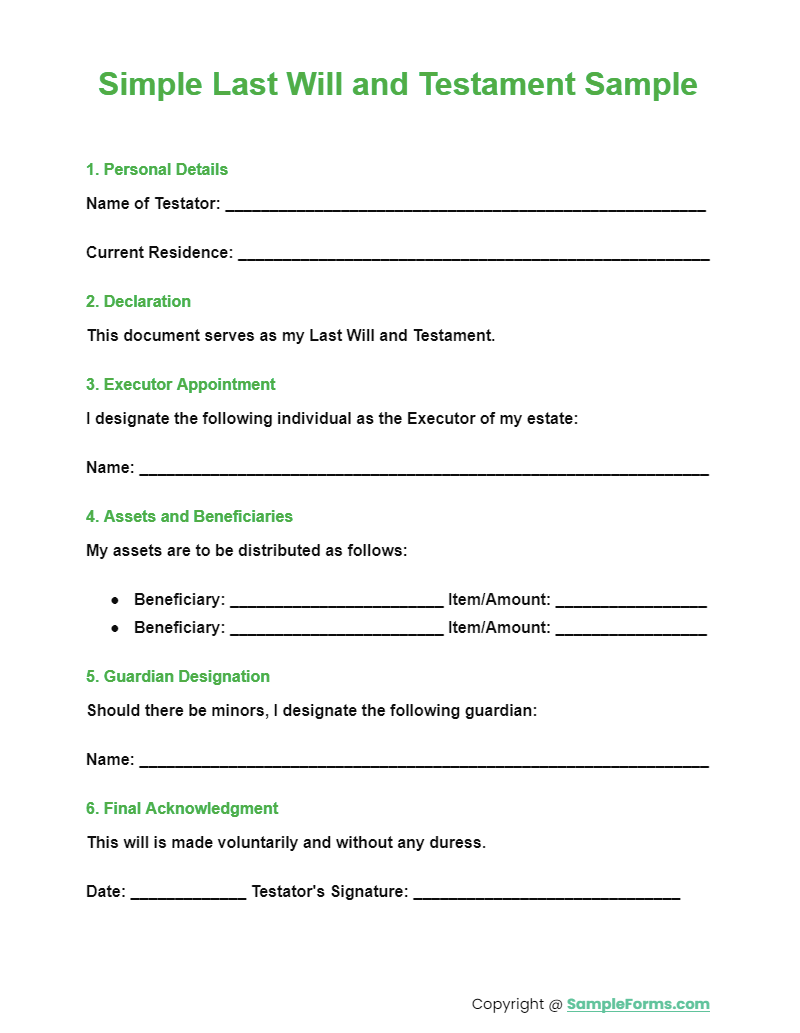
More Last Will and Testament Form Samples
Free Last Will and Testament Form
Printable Last Will and Testament Form
Last Will and Testament Form in PDF
Last Will and Testament Sample Form
Last Will and Testament Simple Form
Printable Last Will and Testament Form
Last Will and Testament Form Example
How do you write a simple last will and testament?
Writing a simple last will and testament involves clear, concise steps to ensure your wishes are legally recognized. Start by identifying yourself and your intent to create the will, declare your mental health, list assets and beneficiaries, appoint an executor, and sign the will in front of witnesses. Incorporating a Legal Form ensures compliance with state laws. You may also see
How to create a last will and testament?
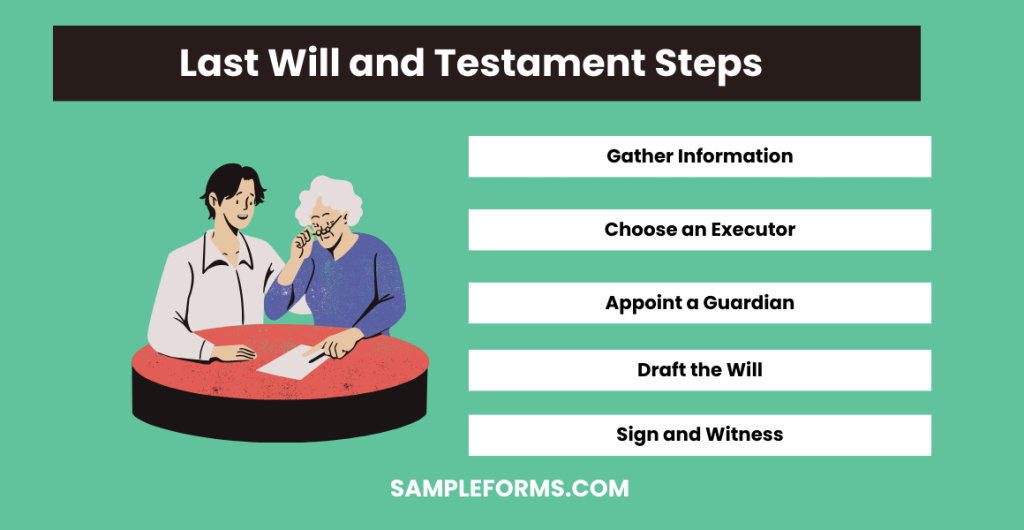
- Gather Information: List your assets, debts, and beneficiaries.
- Choose an Executor: Decide who will manage your estate.
- Appoint a Guardian: If applicable, select a guardian for minor children, using a Legal Guardianship Form.
- Draft the Will: Clearly state your wishes regarding asset distribution.
- Sign and Witness: Sign your will in front of two witnesses to make it legally binding, potentially using a Legal Declaration Form for added formalization. You may also see
How do you write a handwritten will?
A handwritten will, or holographic will, requires:
- Write by Hand: Entirely write the will in your handwriting to ensure it’s recognized.
- State Your Wishes: Clearly express how you want your assets divided.
- Date and Sign: Include the date and your signature.
- Witnesses: While not always required, having witnesses can add credibility. Attach a Legal Statement Form to affirm its authenticity. You may also see
What are the four basic types of wills?
- Simple Wills: Straightforward documents detailing asset distribution.
- Testamentary Trust Wills: Establish trusts for beneficiaries, often including a Legal Ownership Form.
- Joint Wills: Created by two people, typically spouses, that mirror each other’s wishes.
- Living Wills: Specify healthcare directives, complemented by a Health Declaration Form.
How do I create a simple will template?
Creating a simple will template involves:
- Title: Clearly label the document as your last will and testament.
- Identification: Provide your full name and residence.
- Assets and Beneficiaries: List your assets and who inherits them, possibly referencing a Legal Application Form for specific asset transfers.
- Executor: Name an executor to manage your estate.
- Guardian: If needed, designate a guardian for your children, documented through a Legal Services Contract Form.
- Signatures: Conclude with your signature and witness signatures. You may also see
How do you write a will for the first time?

First-time will writing can be straightforward:
- Reflect on Assets: Consider what assets you have, including any Business Declaration Form or Restaurant Legal Form for business owners.
- Decide Beneficiaries: Choose who inherits your assets.
- Appoint an Executor: Select someone to execute your will’s terms.
- Designate Guardians: For those with dependents, pick a guardian, documented by a Declaration Form.
- Draft the Will: Write your will, clearly stating your wishes.
- Sign: Finalize in front of witnesses, and consider attaching an Employment Declaration Form if leaving employment-related assets.
Essential Parts of a Last Will and Testament
- Title – This should clearly state that it is your Last Will and Testament and no one else’s. You may include your Social Security number and address, details that are unique only to you, so that it cannot be interchanged with someone who has the same name. We have Free Will Forms that you can check out for samples before you carry on to the next part. You may also see Property Appraisal Form
- Declaration – Declare that you are of sound mind and of legal age to be writing a will. Also state that you nullify any previous Last and Will Testaments you may have written before, and that you are writing the Will out of your own volition and not due to any outside influence. You may also see Property Information Form
- Executor – The executor is the person who will carry out the terms in your will. He makes sure that all debt, credits, and funeral expenses are paid off. He also decides what kind of probate is necessary or if it is even necessary at all. A probate is a legal process wherein a will is proved and validated in court so that it can be carried out. He also is the one who sells, if necessary, and distributes the properties of the deceased person. You may also see Property Form.
- Guardian – Appoint a guardian for any children under the age of 18, if any. This will be carried out in the event that both you and your spouse would pass away. You may also see Personal Property Bill of Sale Form
- Beneficiaries – Name all the beneficiaries in your will. Name alternate ones as well, to prevent disputes in the case of a simultaneous death of the testator of the will and the beneficiary. You may also see Property Agreement Form
- Assets – Determine which assets are not going to be assigned to a beneficiary automatically at the time of your death and which would be. Those who would not have a beneficiary are those whom you would need to mention specifically in your will. You would then need to state how you want those assets and properties to be divided among the people and organizations listed as your beneficiaries. You may also see Property Statement Form.
- Funeral Arrangements – You could also include details of how you want your remains to be treated after you pass away. You can specify if you want your remains to be cremated or buried. You may also see Property Evaluation Form.
- Signatures – After all the other elements are in the will, you should affix your signature, together with the names and signatures of at least two witnesses. You may also see Property Enquiry Form.
After you have completed your Last Will and Testament, make copies of it. You should store one in a safe place and give one to your executor. You can also see our Property Reservation Form.
Where to get last will and testament forms?
Obtain last will and testament forms from legal document websites, attorneys’ offices, or legal aid organizations. Ensure they comply with your state laws and may include a Legal Declaration Form for authenticity.
Is a last will and testament the same as a will?
Yes, a last will and testament is the same as a will; both terms refer to a legal document that outlines how your assets should be distributed after death. You may also see Property Feedback Form
Can I write my will on a piece of paper?
Yes, a handwritten will, known as a holographic will, is valid if entirely in your handwriting, dated, and signed. However, adding an Employee Declaration Form could formalize employment-related bequests.
How powerful is the last will and testament?
A last will and testament is powerful, legally binding, and ensures your assets are distributed according to your wishes. It may incorporate a Custom Declaration Form for specific items.
How many pages is a simple will?
A simple will might range from one to several pages, depending on the complexity of the estate and the specificity of instructions, possibly including an Assets Transfer Form for clarity.
What is it called when you get money when someone dies?
Receiving money when someone dies is called an inheritance, often detailed in a will or trust, and can involve processes like a Property Transfer Form to legally transfer ownership.
Related Posts Here
-
Mobile Home Bill of Sale
-
Landlord Consent Form
-
60-Day Notice to Vacate Form
-
Financial Statement Form
-
Product Evaluation Form
-
Construction Contract
-
School Receipt Form
-
Restaurant Training Form
-
Daily Cash Log
-
Volleyball Evaluation Form
-
Holding Deposit Agreement Form
-
License Agreement Short Form
-
Fund Transfer Form
-
Business Financial Statement Form
-
Sales Proposal Form
